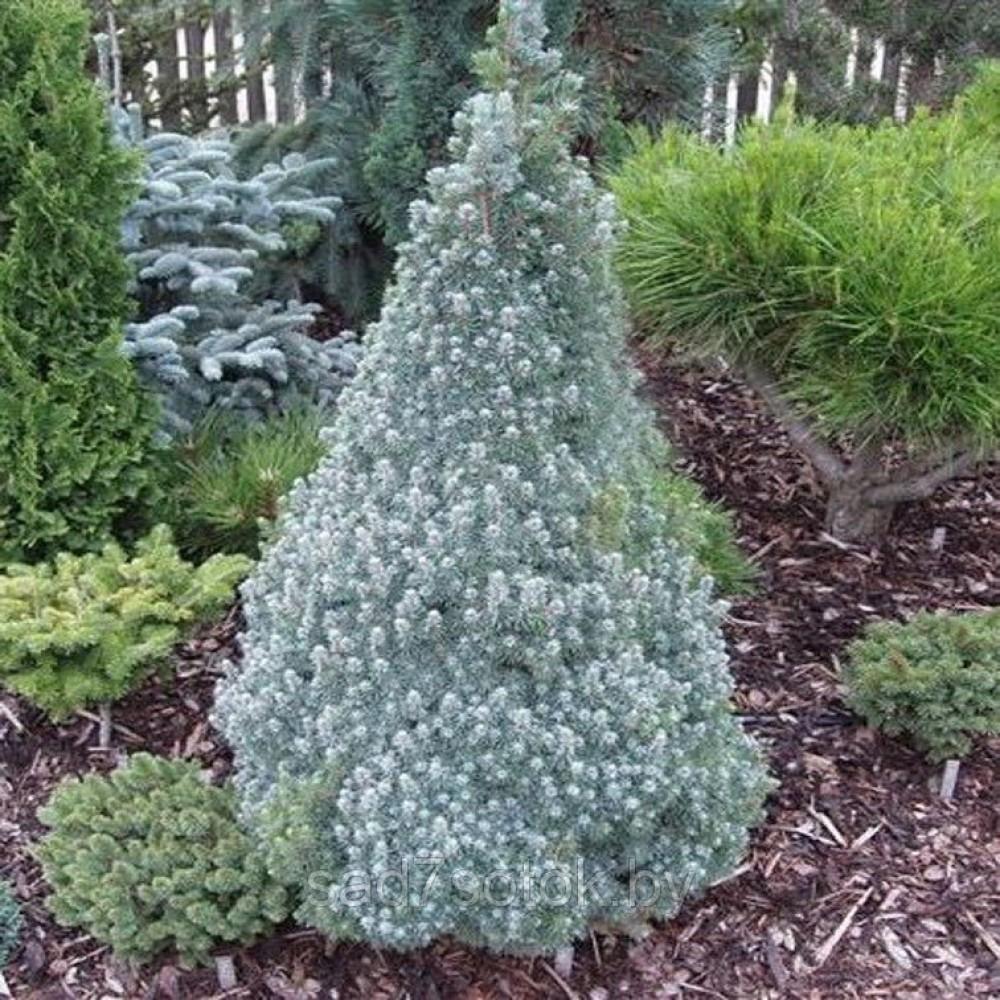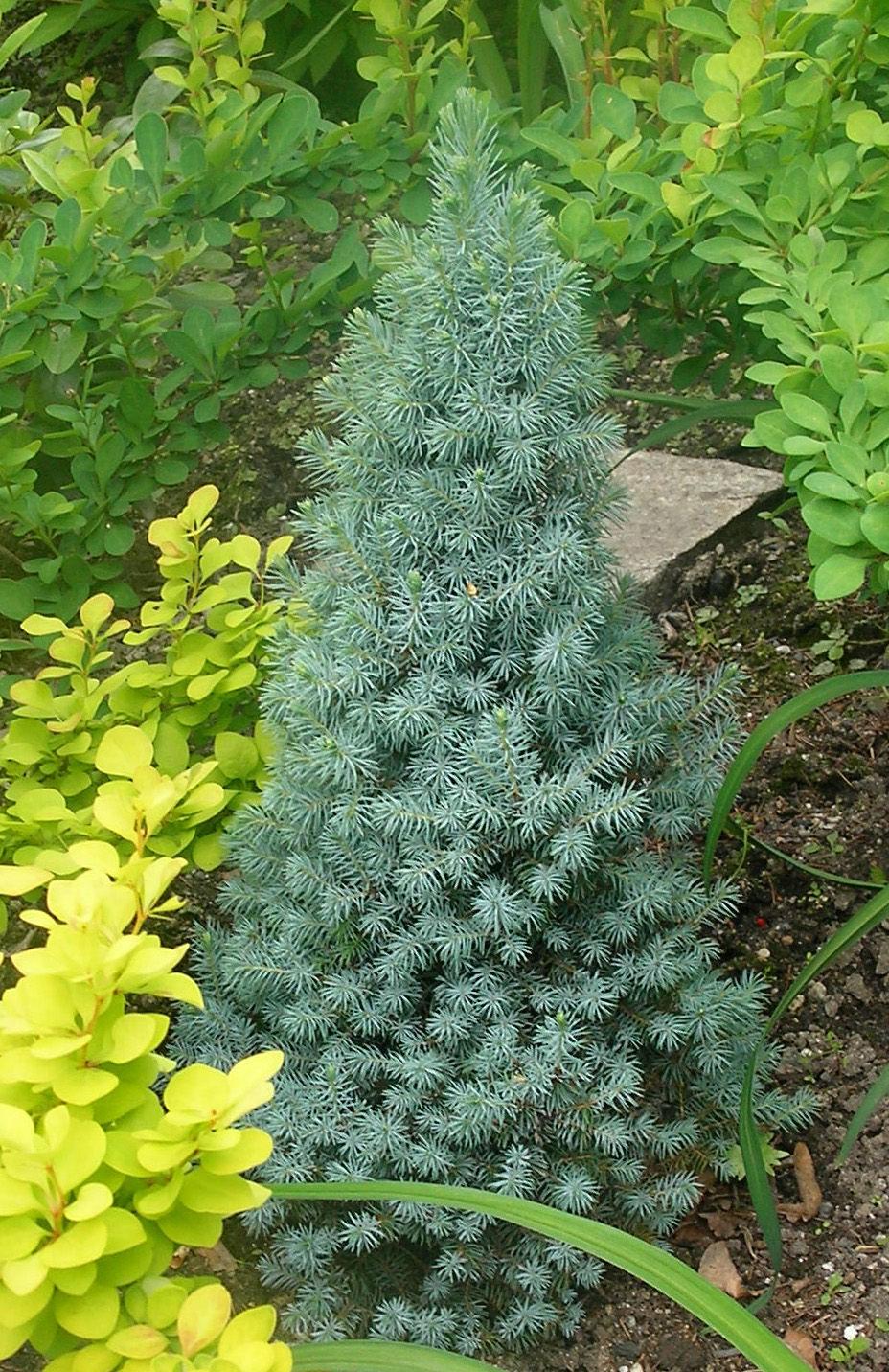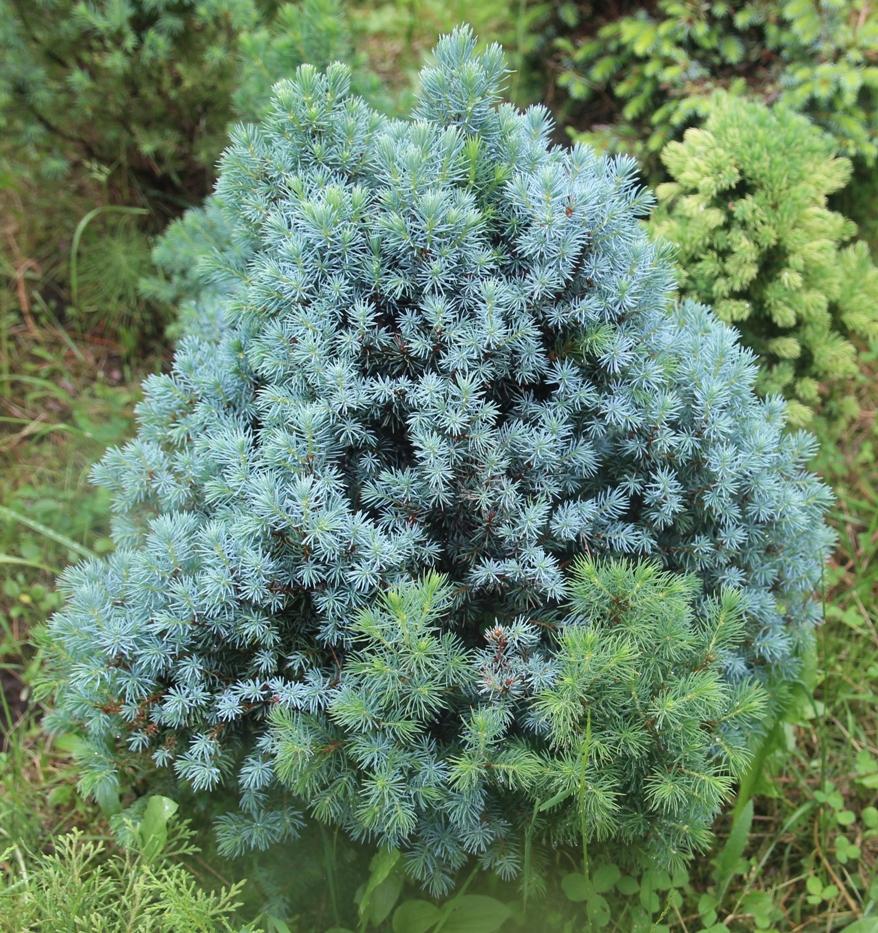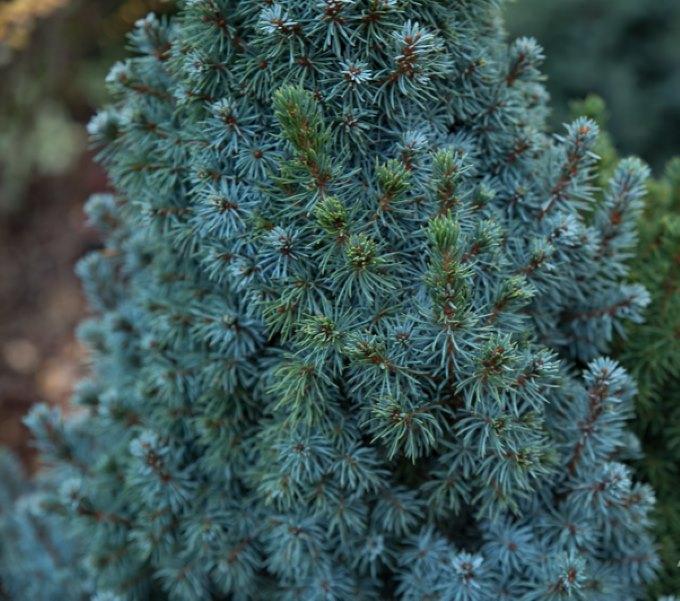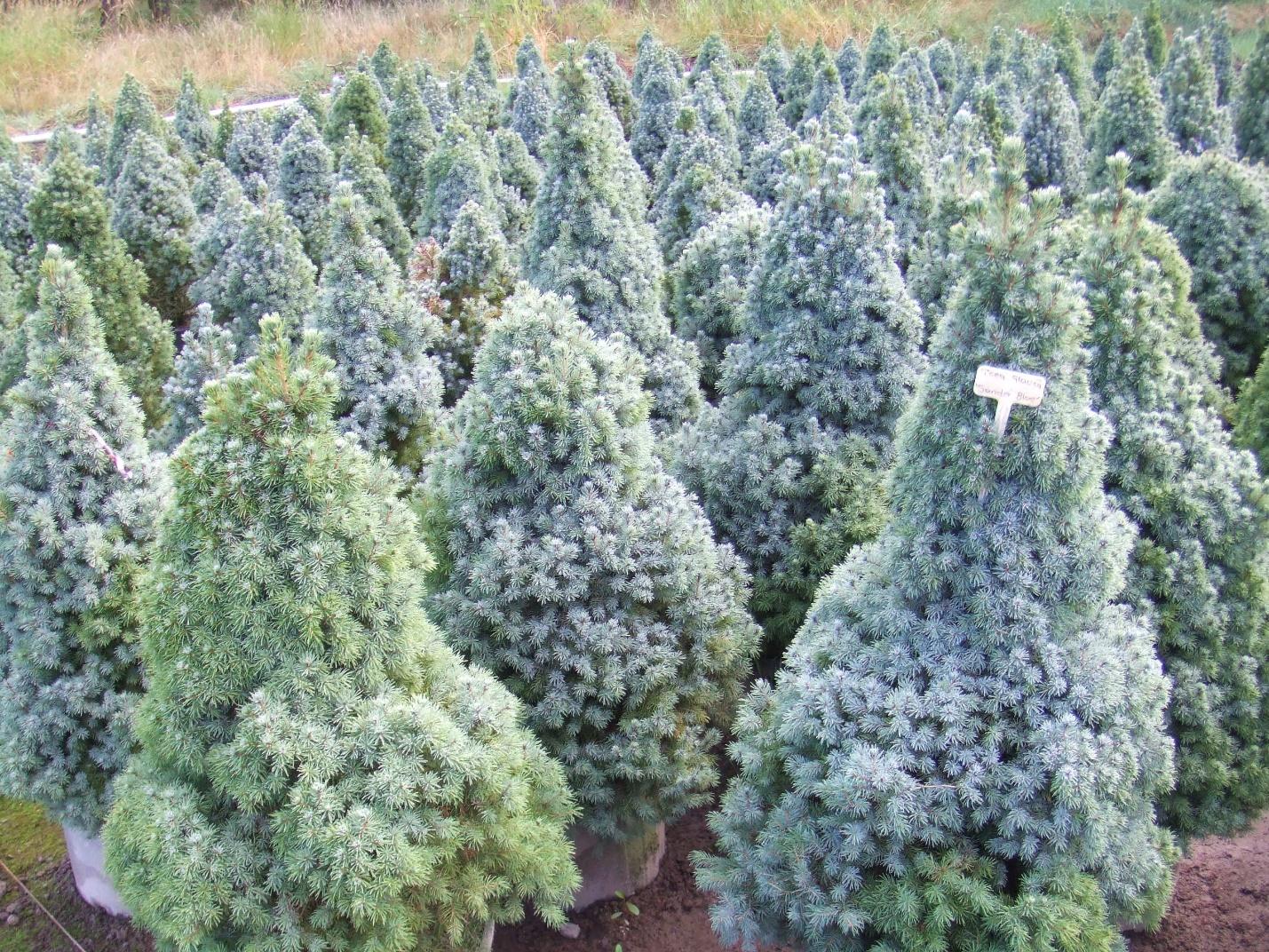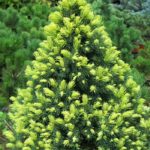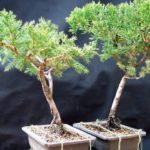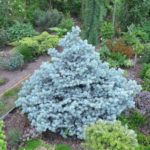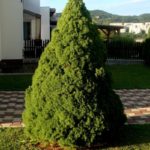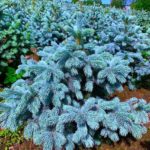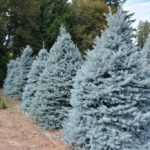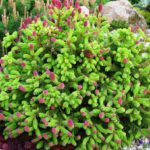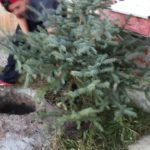Canadian spruce Sanders Blue is a new dwarf variety that was obtained from a mutation of the well-known Konica. This happened in 1986. This culture quickly became popular. This is due to its attractive appearance and great resistance to the sun. Thanks to this, it is possible to simplify care and expand the possibilities for using the plant in landscape design.
Description of the tree
Sanders Blue spruce is an evergreen dwarf plant from the Pine family.It is considered a natural mutation of the Canadian Konica spruce, which was recorded by French dendrologists in 1986. This small plant is characterized by the following features:
- Superficial location of roots and shortened main stem. The root system of spruce is capable of providing the crop with moisture in dry weather, but it does not allow it to maintain wind resistance.
- Trunk tapering upward. It is covered with a thin scaly brown bark.
- Many short internodes on the branches. The shoots extend from the trunk parallel to the ground and bend upward, forming a narrow, conical, squat crown. Over the years, it remains compact, but needs correction.
- Light brown young shoots. They have shiny bark and lack fluff.
- Spirally arranged needles. They are distinguished by their tetrahedral shape and bluish-green color. Young needles are soft, but become rougher with age. It is worth noting that young shoots are covered with bright blue needles.
Spruce of this variety practically does not bloom. At the same time, it retains its decorative properties for a whole year due to its fluffy needles. The advantage of the culture is its slow growth. At the initial stage, the spruce increases by 2-5 centimeters throughout the year.
By the age of 6-7 years, growth rates increase and amount to 15 centimeters. By the age of 10, the spruce grows to 70-150 centimeters in height. Moreover, the diameter of its crown reaches 35-80 centimeters. From the age of 15, spruce develops more slowly. Over the course of a year, it grows by a maximum of 1-3 centimeters.
Where does it grow
The gray Sanders Blue spruce has a fluffy blue crown and is considered very low maintenance. Therefore, this Canadian variety has become widespread in European countries. It appeared in Russia relatively recently, but managed to gain great popularity. The distinctive features of this plant include the following:
- high degree of frost resistance - the tree can withstand temperatures down to -40 degrees;
- resistance to sunburn;
- slow growth;
- resistance to disease development.
Landing rules
To plant a Sanders Blue spruce, you need to choose the right seedling. It is best to buy planting material in specialized nurseries. It is sold in special containers along with soil, which contains a large amount of fertilizer.
After purchase, the crop is planted together with the substrate in the ground. Thanks to this, she better adapts to new conditions. If, after replanting, the spruce begins to shed its needles, this means that the soil in the pot was too dry. Regular watering of the crop will help to cope with the problem. Thanks to this, the needles can gradually recover to their normal state.
It is not necessary to purchase additional fertilizers for planting. When purchasing a seedling yourself, you should give preference to a crop that does not show signs of pest attacks. It is important to avoid trees with damaged branches or trunk. The spruce root system should also be well developed and have a creamy white color.
When to do it
If the Glauka Sanders Blue spruce was sold in a container, planting work can be carried out at any time of the year.When purchasing a seedling with unprotected roots, it must be immediately placed in a clay mash consisting of water, clay and humus. The roots need to be dipped into the composition, sprinkled with sawdust and placed in a bag or wrapped in burlap.
Thanks to this measure, it will be possible to protect the root system from drying out for a week. Before planting, the old clay must be washed off and the root system dipped in the same clay composition, but a growth stimulator must be added to it. Then the mash should be dried a little in the fresh air and you can proceed to planting the crop.
Planting of bare-rooted spruce trees is carried out taking into account the climate of the region:
- in the central regions this should be done at the end of September;
- in the north it is worth planting spruce in early May.
In spring it is recommended to plant plants in containers, but if necessary, this can be done at other times of the year. Since spruce is considered very frost-resistant, it can be planted even in winter.
Hole preparation and planting
To get a spruce of the required height, the planting hole must be at least 70 centimeters. Moreover, its diameter reaches 60 centimeters. A drainage layer measuring 20 centimeters should be provided at the bottom. It should include expanded clay or crushed red brick. The nutritional composition should be prepared from turf soil, humus, acidic peat, sand and clay. You also need to add 150 grams of Nitroammophoska to the substrate.
To begin with, the recess needs to be filled 2/3 with the nutrient composition, filled with water and left for at least 2 weeks. To plant Canadian spruce, it is recommended to do the following:
- Remove some of the soil from the hole.
- Place the tree in the center. It is important to ensure that its root collar is flush with the ground surface.
- Sprinkle the root system with soil and compact it.
- Check if the root collar is in place.
- Make a roller around the perimeter of the crown. To do this you need to use the remaining soil.
- Water the plant generously. It is important that the water reaches the edge of the roller and is absorbed.
- Mulch the soil under the seedling with pine bark or acidic peat.
How to care
In order for Sanders Blue spruce to maintain its decorative properties, it needs to be provided with high-quality care. It must be comprehensive.
Watering and fertilizing
After planting the spruce, it is important to ensure that the soil underneath is sufficiently moist and does not dry out. Subsequently, the number of waterings can be reduced. The crop can withstand short-term waterlogging of the soil, but with constant stagnation of moisture there is a risk of plant death. It is also important to avoid getting the root collar wet. In hot weather, Sanders Blue spruce requires weekly watering.
The plant is highly sensitive to moisture deficiency in the air. This is why it is so important to systematically irrigate the crown. In hot weather, this procedure should be carried out early in the morning or in the evening.
Until the age of 10 years, spruce of this variety must be fed. It is best to use special seasonal preparations for coniferous crops. They have a balanced composition and contain all the elements important for culture. Spring fertilizing includes a lot of nitrogen, while autumn fertilizing mainly consists of potassium and phosphorus.
Weed control
The plant does not develop well in dense, turfed soil.That’s why it’s so important to regularly loosen the soil and remove weeds from the tree trunk. Thanks to this, it will be possible to increase the saturation of the root system with air. The evaporation of excess moisture will prevent waterlogging of the soil and rotting of the roots.
Pruning and preparation for cold weather
At a young age, Canadian Sanders Blue spruce has a symmetrical crown that does not require formative pruning. After some time, it loses its ideal shape, but still retains its decorative qualities. Spruce normally accepts pruning, but it is carried out only if the design idea requires the plant to be perfectly symmetrical.
Carrying out sanitary pruning can cause some difficulties. There are many branches inside the crown. After the needles fall, they dry out quickly. To remove such shoots, you need to push apart the dense branches, densely covered with needles. It takes a lot of time. Therefore, instead of sanitary pruning, they carry out cleaning.
For the winter Canadian spruce you don't have to cover it. Adult plants can withstand frosts down to -40 degrees. However, young seedlings can be covered with spruce branches to protect them from severe frosts and winds. Thaw and sharp frost can damage young seedlings.
How to propagate a tree
Canadian spruce reproduces by vegetative methods. Cuttings take root with difficulty. To do this, you need to maintain certain temperature and humidity parameters. However, even in this case, not all planting material takes root.
Cuttings should be carried out in the spring. It is recommended to harvest planting material from lignified shoots of the middle part of the crown. In this case, it is worth separating cuttings measuring 10-12 centimeters along with the heel.The planting substrate should include perlite or sand. It is also permissible to use a peat-sand mixture.
The cutting needs to be cleared from the bottom of the needles and immersed in a growth stimulator for several hours. After which it is recommended to immerse it 2-3 centimeters in a damp substrate. Then the container must be covered with a bag. In industrial conditions, special fogging units are used.
The greenhouse must be kept in a cool place and watered systematically. It is important to avoid drying out the soil, as this will lead to the death of the cuttings. Overwatering can also lead to the death of planting material.
It takes several months or a year for spruce cuttings to root. It is recommended to plant them in a permanent area only if there are lateral roots.
The main pests for spruce
According to the description, Canadian spruce may suffer from spider mites. They attack the plant when the humidity regime is violated. To protect the plant from parasites, in hot weather it is necessary to water the crop through the crown.
When cobwebs appear on a spruce tree, you need to sprinkle it with an infusion of garlic, tobacco dust or onion peels. If traditional methods do not give the desired effect, it is worth using systemic insecticides - “Aktaru”, “Aktellik”, “Fufanon”.
Application in design
Sanders Blue is often used in landscape design. The culture looks great in rock gardens, rock gardens, and flower beds. It can be planted near heathers and next to other coniferous crops. The plant also looks great in containers.
Sanders Blue spruce has excellent decorative properties, and therefore it is often used to decorate garden plots. In order for a culture to develop normally, it needs to be properly cared for.

